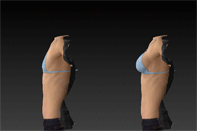PLASTIC SURGERY FAQ
What is Plastic Surgery?
Plastic surgery is a surgical sub-specialty that deals with the healing and restoration of patients with injury, disfigurement or scarring resulting from trauma, disease or congenital defects. It includes aesthetic (also called cosmetic) surgery to correct or rejuvenate facial and bodily features not pleasing to the patient. Derived from Greek, the word plastic means molding or giving form and does not refer to the use of plastic materials.
What qualifies a physician to be a plastic surgeon?
Training to become a plastic surgeon is one of the most rigorous pathways known to medicine. To become board certified by the American Board of Plastic Surgery a physician must complete a specialized post-graduate training course of five to seven years. Background training usually includes a thorough grounding in general surgery however, a background in ENT or orthopaedics may be acceptable; The final two to three years of training must be in an approved plastic surgery training center. Prior to official certification by the American Board of Plastic Surgery the physician must pass a rigorous set of both written and oral examinations. Although numerous physicians use the term “plastic” surgeons only those certified by the American Board of Plastic Surgery are true plastic surgeons.
Does certification by the American Board of Plastic Surgery ensure that a patient will get a perfect result from an operation?
No. Healing of operated tissue is affected by several factors, and some of these are beyond the control of the surgeon. As in any other type of medicine, no guarantee of perfection or even a good result can be given. Nevertheless, the more thorough the surgeons training, skill and experience the greater likelihood for a desirable result. Board certification by the American Board of Plastic Surgery means that the surgeon has completed the rigorous requirements for full time practice as a specialist in plastic surgery.
What types of cases are treated by plastic surgeons?
- Aesthetic (also called cosmetic) problems with the face, neck and trunk, including forehead, eyes, nose, ears, lips, chin, neck, breasts, abdomen, hips, buttocks, thighs, calves, arms, and skin.
- Congenital deformities of the hands and face, including clefts of the lip and palate.
- Benign (non-cancer) and malignant (cancerous) tumors of the head and neck, skin and soft tissues.
- Traumatic injuries of the bony facial skeleton and hand as well as soft tissue injuries of any part of the body.
- Surgery of the hand.
- Surgery of the jaw and facial skeleton.
- Any type of skin cover and replacement problems.
- All types of reconstruction following removal of cancer resulting in disfigurement of any part of the body including the face, breasts, trunk.
What is aesthetic surgery?
Aesthetic surgery, also known as cosmetic surgery, seeks to improve an individuals appearance. These type of operations most often involve the nose, ears, face, forehead, eyelids, breasts, abdomen, hips and thighs.
Is a plastic surgeon a skin specialist?
Although the primary interest of a dermatologist is the skin, the plastic surgeon as an equally important role of the treatment of benign and malignant tumors of the skin. The skills of a plastic surgeon are especially needed when large areas of the skin must be removed and replaced especially where disfigurement may result or when these areas are in conspicuous areas such as the face.
Does plastic surgery leave scars?
Scarring is an inevitable result of the wound healing process. However a very fine lined scar placed in the correct orientation may be virtually invisible. A plastic surgeon has spent years mastering techniques to place scars in the most desirable location. Nevertheless there are certain areas of the body such as the back and chest which produce more severe scarring regardless of the technique used for reconstruction and closure.
What is a keloid?
A keloid is an overgrown or hyperplastic scar. In some patients keloids can grow from 10 to 50 times the size of the original scar. Treatment of keloids is a difficult task although various treatment modalities are available with varying results.
Does plastic surgery always involve skin grafting?
No. Skin grafting is used when it is the best way of closing a wound or defect. A qualified plastic surgeon has years of training to allow good judgment in deciding the best way of reconstructing a defect. A skin graft may appear to have poor color match and texture compared to the native skin, however with careful selection of a skin graft donor site these problems may be minimized.
What is a pedicle graft or flap?
A pedicle graft also called a flap, consists of a segment of skin, underlying subcutaneous tissue and/or muscle which is shifted from one area to an open wound or defect for coverage of that wound. The word pedicle means that the blood supply to the flap is never divided. When the blood supply is completely divided and reattached this is called a free flap, and requires specialized skill in microvascular surgery.
What is rhinoplasty and nasal reconstruction?
Rhinoplasty reshapes the nose usually to improve appearance however it may also be required to relieve breathing problems.
Post-operative pain from rhinoplasty is surprisingly mild. A splint is usually worn over the nose and sometimes inside the nose for five to seven days. There may be some bruising around the eyes however this clears in one to two weeks.
Nasal reconstruction is most often encountered when removal of part of the nose is necessary for cancer removal. Plastic surgeons are specially trained to utilize available tissues to reconstruct the nose and match the pre-operative anatomy as close as possible.
Can the nose be re-operated if the first surgery does not achieve the desired result?
Revisions after rhinoplasty or nasal reconstruction are sometimes necessary. In general, it is prudent to wait approximately one year prior to any additional surgery.
What can be done to correct protruding ears?
Otoplasty is an operation done by plastic surgeons to normalize overly protruding ears. This operation is performed via incisions placed on the back of the ear that are very well hidden post-operatively. Results are excellent from this type of surgery.
What aesthetic surgical procedures are performed to improve the aging face?
There are various degrees and stages of facial aging. Plastic surgeons have undergone very specialized training to address all areas of facial rejuvenation. A face lift tightens and lifts the redundant skin in the face and neck. Additional procedures are available to improve the aesthetics of the forehead, eyes, mouth, chin and neck. Minimally invasive endoscopic techniques are also available. Fine wrinkles of the face may be best treated by laser resurfacing, chemical peels or other skin care treatments.
How is a face lift done?
During a face lift incisions are made in the hair line, temple region extending down in front of the ear and then around the back of the ear into the hairline. These incisions vary depending on the technique used by your plastic surgeon. Many plastic surgeons are well trained in more than one face lift technique. The skin of the face and neck is dissected into the cheeks and neck allowing it to be mobilized upward producing a tightening and smoothing result. Many plastic surgeons now also tighten the muscular layers underneath the skin as well during a face lift procedure. Years of specialized training are necessary to safely perform this procedure. However, spectacular results are possible.
Does a face lift leave scars?
Yes, however, as with other scars plastic surgeons have been trained to place them in areas that are very inconspicuous. Your plastic surgeon will be able to show you exactly where your scars will be following your surgery.
Brow lift – A brow lift elevates the brows/forehead to their aesthetic position, as well as the obliteration of the transverse forehead wrinkles and vertical frown lines. Depending on each patient, the approach may be done with an open incision or a minimal incision endoscopic technique.
How is excessive wrinkling and bagginess of the eyelids corrected?
Blepharoplasty is the procedure done to correct this condition. Excessive skin and fat may be removed from both upper and lower eyelid. Tightening of the lower lid may also be done in concurrence with this procedure. One to two weeks of bruising and swelling is expected from this procedure. Blepharoplasty may be done in combination with or separate from face lifts or other types of aesthetic surgeries of the face such as brow lifts.
What operations are performed to improve the appearance of the breasts?
Three common procedures are performed: augmentation mammaplasty, mastopexy, reduction mammaplasty.
Augmentation mammaplasty is a procedure that can safely enlarge a small breast. Various techniques are utilized, however, in general this is done using a saline breast implant. Implants may be placed in different positions depending on the physical make-up of the patient and her breasts. The implant may be introduced through three different incisions: below the breast, around the nipple areolar complex, or in axilla (arm pit).
Mastopexy or breast lift is used when the patient is happy with the size of her breasts however due to aging and pregnancy the breast gland has begun to droop. Various techniques are employed to accomplish a breast lift and results are generally excellent.
Reduction mammaplasty or breast reduction is designed to make overly large breasts smaller. Patients seeking this type of surgery often have multiple severe physical symptoms secondary to their large breasts including neck, shoulder, back pain, paresthesia of the arms and bra strap grooving of the shoulders. The technique of reduction mammaplasty requires lengthy incisions; however, they may be placed in inconspicuous locations such as the fold underneath the breast. Typical symptoms of back pain, neck pain etc. are almost always improved after reduction mammaplasty if not completely eliminated. This procedure is often covered by insurance.
Can tattoos be removed?
Tattoos can be difficult to remove depending on the type and color. Presently the use of the YAG laser offers some of the best results in tattoo removal. Generally speaking six to eight treatments spaced six weeks apart are required for satisfactory results.
If you have more questions about plastic surgery, contact us today and we will provide you with the information you need.










